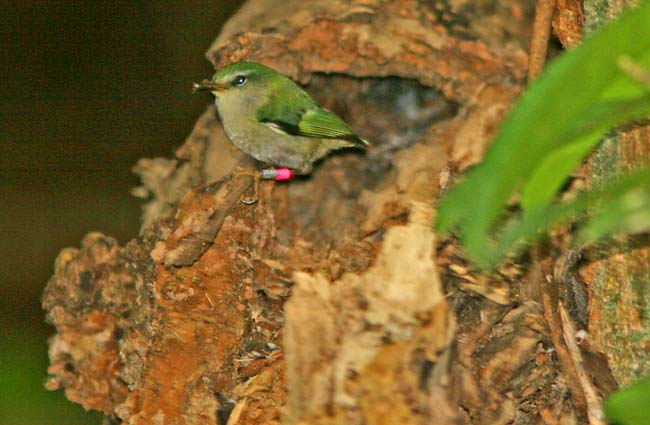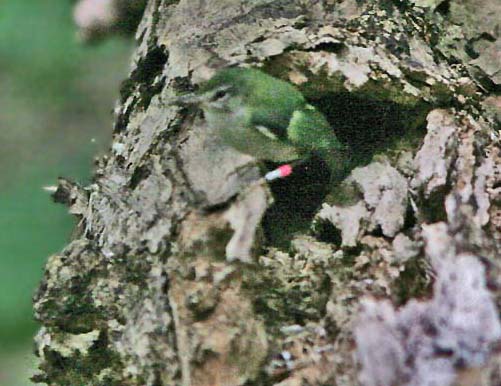
a web page by Don Roberson |
NEW ZEALAND WRENS Acanthisittidae |
|
"The New Zealand wrens have a zoological importance out of all proportion to their restricted world distribution and limited diversity, not to mention their faint vocalizations, small size and comparative drabness. Recent studies, involving analysis of DNA, indicate that they are the most 'primitive' of the living passerines, in the sense that their ancestors were the earliest to diverge from the main passerine lineage;" Gill (2004). |
| Both New Zealand wrens are absolutely tiny birds; Rifleman weighs as little as 5.0–5.7 grams. This is just smaller than Golden-crowned Kinglet Regulus satrapa, which runs 5.3–5.8 grams. Rifleman forages in middle and lower tiers of native forests; the South Island Wren is mainly terrestrial among rocky alpine scree. It is quite amazing to think that this tiny little bird is the most ancient and 'primitive' of all the songbirds on earth. |
 Rifleman
is by far the most widespread and best-known member of the family.
Despite the loss of native habitat, it remains reasonably common on
North, South, and Stewart Island, and it has adapted to some non-native
habitats. The species had just been reintroduced to Tiritiri Matangi
Island when I visited in 2009; the photo (right) is of a male at the
first nest on Tiritiri. It is obviously banded, and is carrying food
for young inside the nest cavity. Rifleman are monogamous and form
long-term pair bonds that last several years. Both sexes help feed the
young. Some Rifleman nest in pairs but others breed co-operatively,
with extra adults or youngsters helping at the next (Gill 2004). Rifleman
is by far the most widespread and best-known member of the family.
Despite the loss of native habitat, it remains reasonably common on
North, South, and Stewart Island, and it has adapted to some non-native
habitats. The species had just been reintroduced to Tiritiri Matangi
Island when I visited in 2009; the photo (right) is of a male at the
first nest on Tiritiri. It is obviously banded, and is carrying food
for young inside the nest cavity. Rifleman are monogamous and form
long-term pair bonds that last several years. Both sexes help feed the
young. Some Rifleman nest in pairs but others breed co-operatively,
with extra adults or youngsters helping at the next (Gill 2004). |
Fossil evidence shows the existence of at least 7 species of acanthisittids, in five genera. Three flightless species died out some time aster Maori settlement (about 1250). The flightless Stephens Wrens Traversia lyalli went extinct shortly after its discovery on tiny Stephens Island, in Cook Strait, apparently wiped out by the lighthouse keeper's cat. Bush Wren Xenicus longipes once occurred on all major islands, but the last probably observation was in 1968 on South Island; it is now considered extinct. South Island Wren has a rather fragmented distribution high in the mountains of that island. It is usually called "Rock Wren" but that name conflicts with that of a New World species — Rock Wren Salpinctes obsoletus — which is a member of the true wrens Troglodytidae. Dickinson (2003) tried using "Alpine Rock Wren" for the New Zealand acanthisittid, but adding a modifier to one "rock wren" would require adding a modifier to all "rock wrens." The most recent Clements' checklist using South Island Wren for Xenicus gilviventris, but there may be a better alternative choice. |
Photos: The Rifleman Acanthisitta chloris was at an active nest of Tiritiri Matangi I., off North Island, New Zealand, in Nov 2009. Photo © D. Roberson; all rights reserved. Bibliographic note: There is no "family book" per se, but a fine introduction to this family, with some nice photos, is in Gill (2004). Literature cited:
|
 The New Zealand wrens are two tiny passerines restricted to New Zealand. Rifleman (left) is found on both North Island and South Island; the South Island Wren (often called "Rock Wren") Xenicus gilviventris is found only in alpine habitats on the South Island. Several species became extinct since man colonized New Zealand.
The New Zealand wrens are two tiny passerines restricted to New Zealand. Rifleman (left) is found on both North Island and South Island; the South Island Wren (often called "Rock Wren") Xenicus gilviventris is found only in alpine habitats on the South Island. Several species became extinct since man colonized New Zealand.